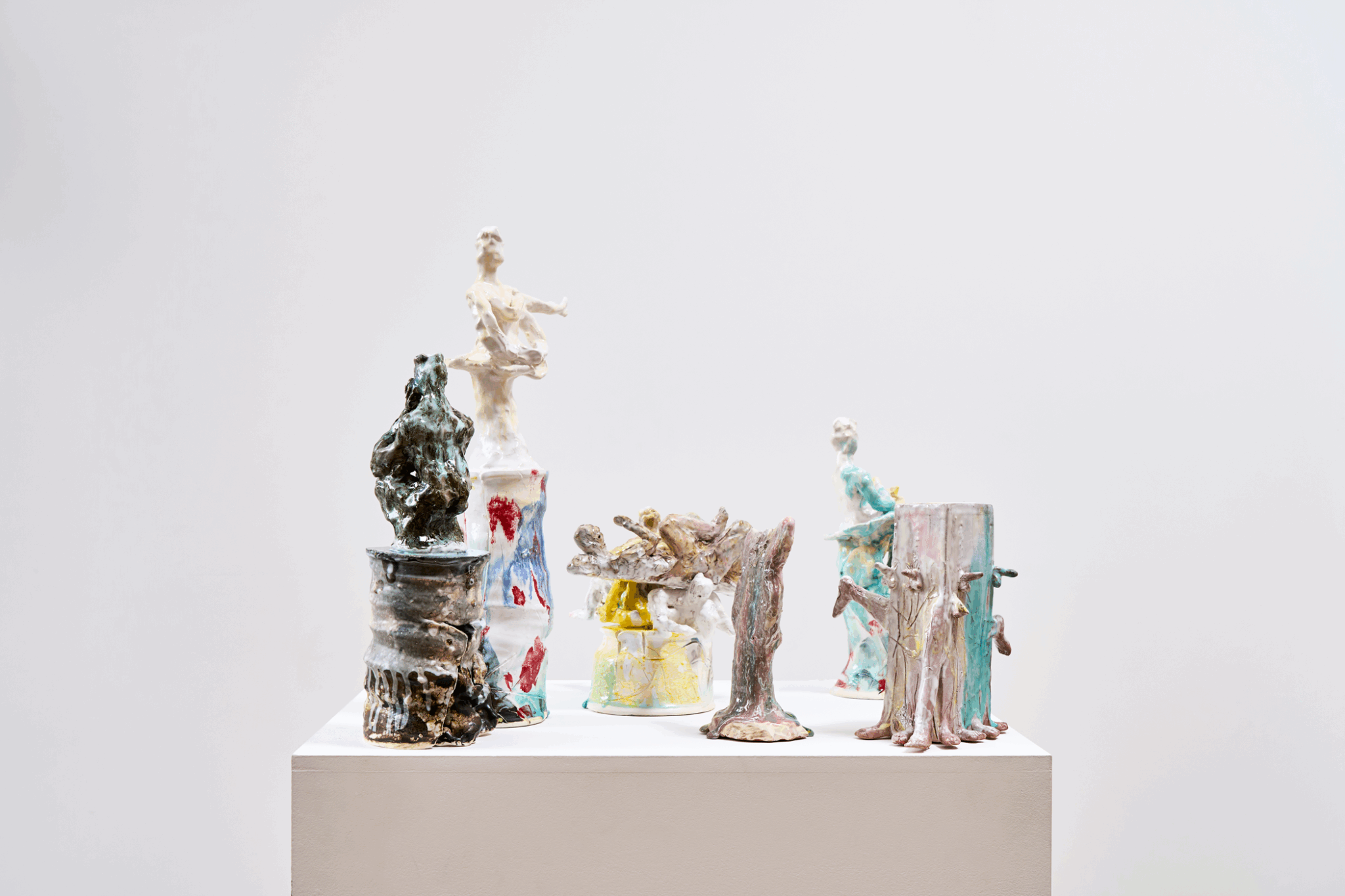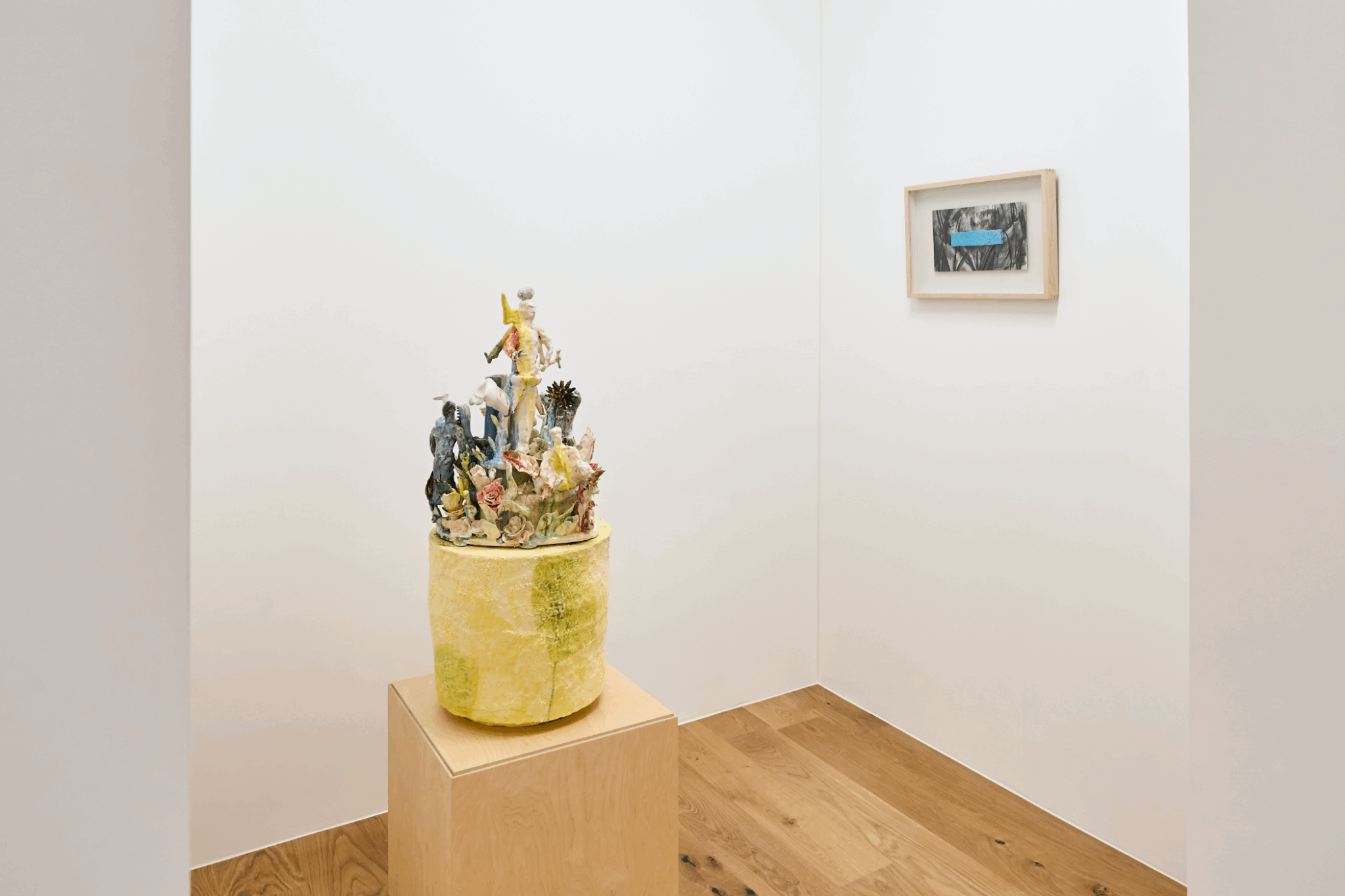Exhibition
All That Is Not Mine
내가 아닌 모든 것

INSTALLATION VIEW “All That Is Not Mine”, 2025. Courtesy of the Artist and KICHE.
All That Is Not Mine, on the surface, refers to what lies beyond the self. Yet, the very moment this phrase is uttered, it paradoxically highlights and evokes the presence of the “self” in one’s mind. Here, “all that is not mine” ultimately signifies “everything that constitutes me.” The two artists appear to direct their work as observers, choosing queer friends or a father as models, seemingly focused on examining and portraying others. However, their artistic approaches and attitudes do not reflect a detached third-person perspective; rather, they move toward narrowing the distance with their subjects, fostering a sense of identification.
For both Dan Kim and Jiyong Kim, maintaining an objective distance from the subject is not a main concern. On the contrary, Dan Kim selects those around him with whom he shares a queer identity, while Jiyong Kim chooses his father—a figure who has shaped his ontological sense of self. For this reason, the figure who stands or sits quietly in a corner of the studio becomes not only a subject of making or drawing, but also a mirror onto which the artist projects their own self. His body becomes the artist’s body; his story, the artist’s own. His body now becomes the artist’s own, and his story, in turn, becomes the artist’s narrative. Despite differences in artistic form and methodology, this act of narrowing the psychological distance between subject and self—ultimately merging the two into a singular, interconnected “I”—is a striking throughline in both artists’ practices.
Dan Kim’s fired clay sculptures appear either as singular forms placed on a pedestal or as clustered masses of figures bound together. For this exhibition, the artist invited six friends to serve as models for his new works. Each model shares a queer identity, yet represents a distinct bodily expression—ranging from a transgender, a drag queen, a male ballerino, and a gay man. Following the facial expressions, gestures, and emotional contours of his models, Dan Kim sculpts by layering and overlapping unique lines and movements in clay. To achieve a desired aesthetic—whether through form, the blending or dripping of glazes—he sometimes incorporates ornamental objects or fragments of discarded ceramics into the sculpture, and repeatedly fires the pieces in an electric kiln, adjusting temperatures across multiple firings. One of the new works, You, me, and us is presented as a mirror-based installation featuring six identical standing figures in the same tucking pose. Rather than aiming for hyper-realistic detail, the figures capture only the essential features or moods of each body. Positioned beside a mirror, the viewer sees the title reflect-You, me, and us—as overlapping gazes converge into a single reflection, prompting a moment of recognition: you, me, and us are, in essence, one.
Jiyong Kim has focused almost exclusively on one subject—his father—from the time he began working with family photographs to his current practice of drawing from live models. After graduating from university, Kim continued to work independently, developing his drawing and painting practice in a largely self-taught manner. Choosing to depict a family member he knows intimately was perhaps a natural decision. Although considerable time has passed since his first solo exhibition at YEEMOCK Gallery in 2020, his father still occupies a central place in his work. Moreover, Kim’s repeated depiction of the same subject does not stem from a position of detached observation, but from a growing awareness of an inevitable identification with his subject. Rather than resisting this, he embraces it as an essential part of his artistic process—one that lends emotional depth to his work.
Recently, he has expanded his focus beyond painting into semi-abstract works and sculpture, experimenting with new materials such as tissue, milk cartons, clay (used for the first time in this exhibition), and sandpaper (originally used for erasing oil paint surfaces). These rough techniques and unfamiliar media carry a certain weight, evidence of the physical and temporal labor behind his practice. For Kim, “seeing and depicting” is not a matter of representing either surface or essence, but an act of pushing both forward in balance—a process rooted in accumulated time and discipline. His new works Head 3 and Head 2, which are conceptually linked, embody this balance. In the paintings, he applies background color, carves out the lines of the form, and then fills, scrapes, and wipes away the paint to create semi-abstract images. The sculptures, made of clay, take on the contours of heads; Kim cuts into the forms with his hands and knife, shaping them into detailed features and finishing the surfaces with wax and pigment.
Dan Kim and Jiyong Kim, though differing in their methodologies, both reveal a distinctive sense of freedom. Centering their work around “form,” they primarily engage with traditional media such as ceramics and painting, yet they do not confine themselves excessively within these frameworks. Their approach reflects a determination to seek a formal language that allows them to express and embody the self more authentically, rather than being trapped by conventional forms and narratives. As a result, the works born from their raw and sincere thoughts and gestures exhibit a flexible quality, as if moving to a lively rhythm.

INSTALLATION VIEW “All That Is Not Mine”, 2025. Courtesy of the Artist and KICHE.
《내가 아닌 모든 것》은 표면적으로 ‘나’의 바깥을 지시하지만, 이 말을 입에 올리는 순간 머리 속에선 오히려 ‘나’라는 존재를 부각해 떠올리게 하는 역설과 연관된다. 따라서 여기서 언급되는 ‘내가 아닌 것들’은 곧 ‘나의 모든 것들’을 가리킨다. 두 작가는 성소수자 친구들이나, 아버지를 모델로 삼고 있어 작업의 방향이 ‘관찰자로서’ 다른 대상을 살피고 담아내는 데 있는 것처럼 보인다. 그렇지만 그들이 견지하는 작업방식과 태도는 3인칭이 아니라 오히려 대상과의 거리를 좁혀 동일시하는 것에 더 가깝다.
김대운과 김지용에게 ‘대상과의 객관적 거리’를 유지하는 일은 중요한 관심사가 아니다. 오히려 김대운이 성소수자로서 정체성을 공유하고 있는 주변인들을, 김지용이 존재론적 정체성을 부여해준 아버지를 모델로 선택하고 있는 점에서 그 정서적 거리는 매우 가깝다. 이 때문에 작업실 한 켠에 서거나 앉은 ’그‘는 만들기, 그리기의 대상이면서 ‘나’의 자아를 투사하는 거울이다. 이제 그의 몸은 나의 몸이고, 그의 이야기는 곧 나의 이야기이다. 또한 작품 형식이나 방법론이 각기 다름에도 이렇듯 작업과정에서 대상과의 심리적 거리를 좁혀 하나로 연결된 ‘나’로 설정하고 있는 것은 두 작가의 작업에서 눈에 띄는 점이다.
김대운의 흙으로 빚어 구운 입체들은 단상 위에 단일하게 또는 여럿이 한데 덩어리로 뭉쳐진 형상들이다. 이번 전시 작품들을 위해 그는 여섯 명의 친구들을 불러 각각 작업 모델로 세웠다. 이들은 작업 안에서 성소수자의 정체성을 공유하는 대상들이면서, 트랜스젠더, 드랙퀸(Drag queen), 남성 발레리나, 게이 등 각각 다른 개별성을 표출하는 신체들이다. 그는 모델로 선 인물의 표정, 몸짓, 감정선을 따라가면서 고유의 몸짓, 선을 겹치도록 하거나 쌓아가면서 흙으로 빚고, 그에 걸 맞는 형태, 유약의 섞임이나 흘림 정도 등 의도하는 미적 감각을 구현하고자 형상 자체 또는 장식적 오브제나 버려진 도자기 등을 부분적으로 추가하면서 많게는 수차례까지 전기가마에 넣어 온도를 달리해가며 굽기를 거듭했다. 거울을 이용한 설치 형식의 신작 <너와 나 우리>는 터깅(Tucking)한 모델의 형상이 여섯 개의 동일한 포즈 입상으로 분화돼 거울 옆에 서 있는 작품이다. 형상들은 구체적인 묘사보다 대략적인 포인트, 느낌 정도만을 담아내고 있다. 작가는 작품 제목처럼 세 시선이 한 거울에 겹쳐 보이게 함으로써 너, 나, 우리가 한 몸임을 떠올리도록 감상자를 이끈다.
김지용은 가족사진을 소재로 삼던 때부터 직접 모델을 세워 작업하게 된 현재까지 거의 아버지 한 사람을 다뤄오고 있다. 대학 졸업 후 독학하듯 드로잉, 회화 작업을 이어온 그가 가장 가깝고, 잘 알고 있는 가족을 작업대상으로 삼은 것은 어쩌면 자연스런 선택이었다. 2020년 이목화랑에서의 첫 개인전 이후 상당한 시간이 지났지만 아버지는 그의 작업에서 여전히 큰 비중을 차지한다. 덧붙여 같은 대상을 반복해 그리는 동안 일정 거리를 유지하는 객관적 관찰자가 아니라, 부득이하게 그 대상과 일체화되는 것을 인식하면서 이를 거쳐야 할 과정으로 받아들이고 있는 점은 그의 작품에 깊이감을 부여하는 원천이다. 최근 반추상 회화, 두상 조각으로 관심을 넓히고 휴지, 우유곽 그리고 이번에 처음 쓴 흙, 사포(유화 표면을 닦아내는 데 쓰던) 등 재료를 달리해 입체 작업들을 시도하며 형식과 매체를 꾸준히 다변화하고 있다. 거친 방식과 낯선 재료들이지만 묵직함이 배어 있다. 이는 ‘보고 그리는 행위’가 겉면이나, 내면 어느 한 쪽으로 기우는 게 아니라 양쪽을 균형 있게 앞으로 밀고 나가야 하는 것임을 몸으로 실천하며, 축적해온 시간의 힘이다. 연결된 작품으로 묶인 신작 <두상 3>, <두상 2> 는 바탕색을 칠하고, 형상의 선을 파낸 후 다시 물감을 채워 긁고, 닦아낸 반추상의 회화 작업과 흙으로 두상의 윤곽을 빚고 손, 나이프로 파내 세부 형태를 잡아 촛농, 안료로 마감한 조각이다.
김대운, 김지용은 그 방법론은 서로 다르지만, 특유의 자유분방함을 드러낸다. ‘형상’을 중심으로 도자, 회화라는 전형적인 형식을 작업의 주무대로 삼되, 그 틀에 과도하게 갇히지 않는다. 작가들의 그런 접근은 뻔한 형식, 서사에 매몰되지 않고, ‘나’를 더 나답게 드러내고, 담아낼 수 있는 형식언어를 찾으려는 의지를 반영한다. 따라서, 그 투박하고, 솔직한 생각, 몸짓들이 만들어낸 작품들은 경쾌한 리듬을 타는듯 유연하다.

INSTALLATION VIEW “All That Is Not Mine”, 2025. Courtesy of the Artist and KICHE.
2025. 07. 03. (Thu) – 08. 02. (Sat)
KICHE